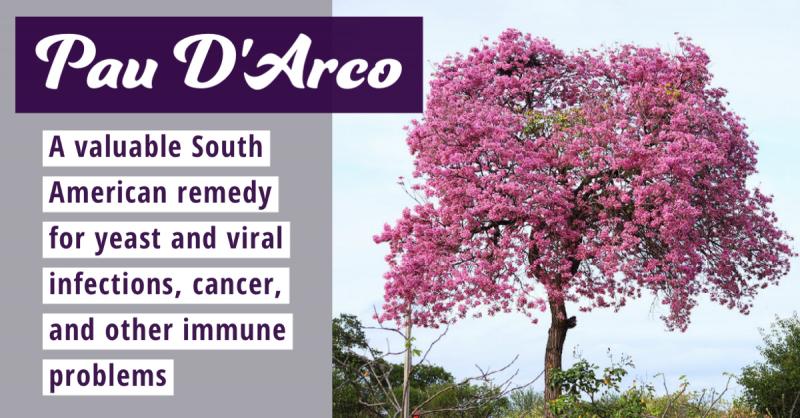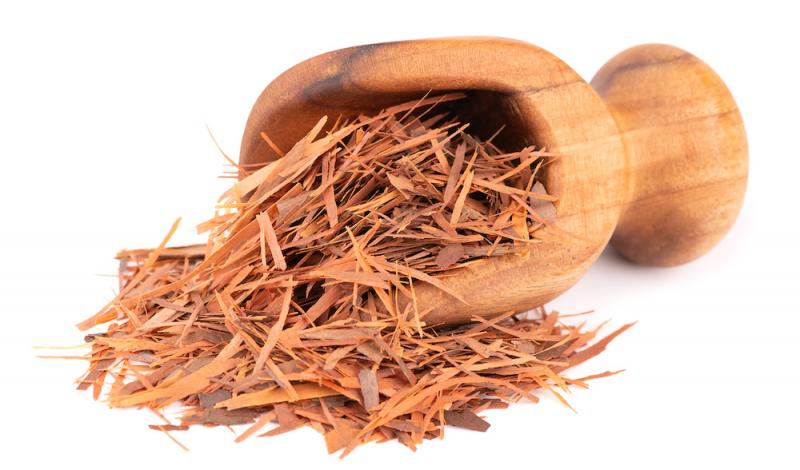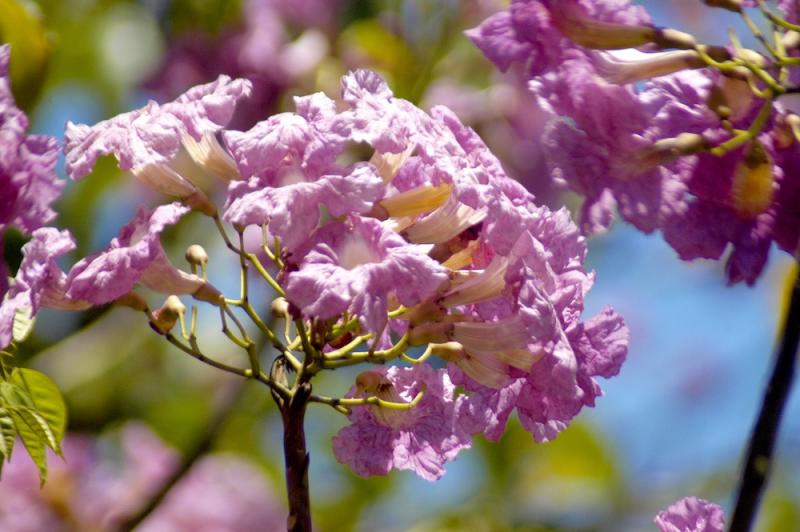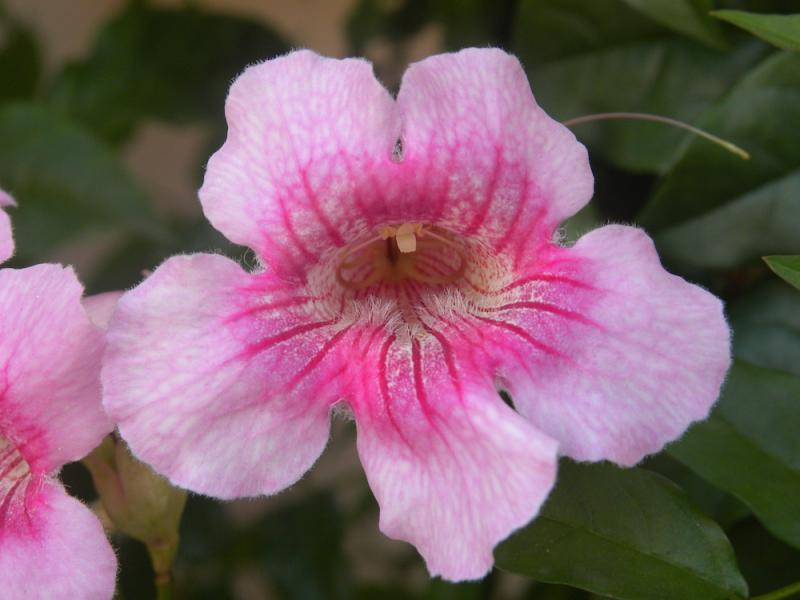
South America is a rich source of valuable herbal medicines that we’ve barely begun to utilize. Edward Milo Millet, the herbalist who helped me get started in my career, had been to South America and told me there were many wonderful plants he’d seen there that were yet to be brought to the attention of North American herbalists. A few that have been brought into commerce include maca, cat’s claw, and the herb I’ll be writing about today, pau d’arco.
Pau d’arco is a tree, native to Central and South America and the West Indies. It can reach a height of 125 feet and can withstand severe winds. Its flowers can range in shade from rose to violet, which blooms in profusion just before the leaves appear. It has been used by South American natives to treat a diverse variety of ailments, including ulcers, malaria, diabetes, arthritis, and cancer.
Research on the plant is somewhat limited. It contains naphthoquinones, particularly lapachol and beta lapchone, which have been shown to have antibacterial, antifungal, antiviral, antitumor, and antimalarial activity. A North American herb that contains the naphthoquinone juglone, is black walnut, which shares some similar, but not identical uses.
Pau D’arco and Candida (Yeast)
 The main thing I’ve used pau d’arco for is to treat fungal and yeast infections. I’ve seen some people get very good results from using it, especially in a tea form. And, because it is a bark, decocted teas work the best.
The main thing I’ve used pau d’arco for is to treat fungal and yeast infections. I’ve seen some people get very good results from using it, especially in a tea form. And, because it is a bark, decocted teas work the best.
To make a decoction of pau d'arco bring one quart of water to a boil, add one heaping teaspoon of the bark pieces, reduce the heat, and simmer on low for 20-30 minutes. Drink two to four cups per day, drinking some of the tea every four hours or so. I’m not a big tea fan, but I think pau d’arco tea tastes pretty good.
I’ve seen this help women with vaginal yeast infections and people who suffer from intestinal dysbiosis, which we used to think of as systemic Candidiasis, or yeast overgrowth, but I think is more correctly thought of as a poor balance of intestinal microbes. The symptoms include gas and bloating, cravings for sugar, brain fog, fatigue, and sinus congestion. I think that like black walnut, it probably also helps to tone up leaky gut.
Of course, all this works best in conjunction with some dietary changes. Stop eating all simple sugars and refined carbohydrates like white flour and white rice. Eat some fermented vegetables and/or take probiotic supplements, too.
Immune Benefits of Pau D’arco
 Pau d’arco is used to treat cancer in Brazil, and there are reports of it being able to help shrink tumors and help with leukemia, but I would never think of it as a stand-alone remedy for cancer. It would best be used as part of an overall approach to cancer. It can be used as an adjunct to medical treatments for chemotherapy and has been reported to ease pain, reduce hair loss, and help maintain better immune function.
Pau d’arco is used to treat cancer in Brazil, and there are reports of it being able to help shrink tumors and help with leukemia, but I would never think of it as a stand-alone remedy for cancer. It would best be used as part of an overall approach to cancer. It can be used as an adjunct to medical treatments for chemotherapy and has been reported to ease pain, reduce hair loss, and help maintain better immune function.
The herb can also be helpful for viral infections. It’s not a remedy that I would pick for a common cold, but it has been helpful for some of the more chronic viral infections, such as herpes. Take the herb immediately following the first symptoms of a herpes outbreak and continue using it until the outbreak has been contained. It can be used internally and/or applied topically.
Pau d’arco also inhibits H. pylori, the bacteria associated with stomach ulcers, and can help to heal gastric ulcers. It may also be helpful for malaria and topical MRSA infections.
Other Uses Pau d’arco
 Pau d’arco acts as an alterative (like burdock and red clover) to clean up the internal environment of the body and heal skin diseases skin diseases. It can be taken internally and applied topically to help heal eczema, psoriasis, wounds, and possibly even skin cancers.
Pau d’arco acts as an alterative (like burdock and red clover) to clean up the internal environment of the body and heal skin diseases skin diseases. It can be taken internally and applied topically to help heal eczema, psoriasis, wounds, and possibly even skin cancers.
I’ve used a lotion made with pau d’arco for a variety of problems. It makes a reasonably effective underarm deodorant, for example, and I’ve also applied it topically to help heal hemorrhoids.
There are many other problems for which pau d’arco has been traditionally used. These include fevers, snake bites, and inflammation. My take on it is that it is that by balancing the intestinal flora, it probably helps to clear up a lot of other health problems. It does have some anti-coagulant properties, so it should be avoided with blood clotting disorders. Large doses may cause some gastrointestinal upset, but this probably won’t happen if you use the tea and start slowly so you gradually clean your system out. It should also be used cautiously, or avoided entirely, during pregnancy.
One final thing to note is that you have to get a good quality herb for effectiveness. According to Herbal Therapy and Supplements by Merrily A. Kuhn and David Winston, much of the plant material in the American marketplace has lower levels of naphthoquinones than the material used as medicine in Brazil. So, the quality of the bark may make a difference in how effective it will be for you. So be sure to get it from a reliable source.
Downloads
Steven's Articles
-

-
The Sensible Use of Caffeinated Herbs
Kola nuts, guarana, and yerba mate and other herbs…
-

-
The Health Benefits and Problems with Coffee
This popular caffeinated beverage can be beneficial…
October
-

-
Understanding Caffeine & Cellular Adaptation
Preserving the power of caffeine's buzz and the…
September
-

-
Horseradish
A pungent spice for aiding protein metabolism…
-

-
Banaba or Crepe Myrtle
A beautiful tree from Southeast Asia whose leaves…
August
-

-
Monkeyflowers
Flower essences to help see ourselves more clearly…
-

-
Mariposa Lilies
Strengthening the bond between mother and child…
-

-
The Noble Bay Leaf
A common kitchen herb for aiding digestion and…
-

-
Epimedium: Horny Goat Weed
A circulatory stimulant and kidney yang tonic…
July
-

-
The Medicinal and Nutritional Benefits of Apricots
A nutritious fruit and valuable medicinal seed for coughs
-

-
Dogwoods
Asian dogwood is used to stop excessive discharge,…
June
-

-
Neem: The Village Pharmacy
A popular Ayurvedic remedy for dental and immune…
-

-
Spilanthes: The Toothache Plant
A traditional remedy for teeth and gums, as well…
-

-
Forsythia
An anti-inflammatory, fever-reducing, and infection fighting herb
May
-

-
Buckwheat (Kashi)
A delicious, high protein, gluten-free, gut-healthy food

